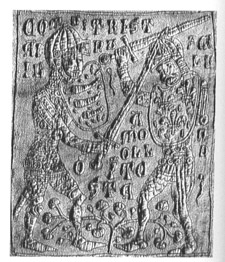




(picture from Loomis p 38, Staniland p 40, Eddy p 52)
1395 Apx - Tristan Quilt #1
This quilt currently resides in a drawer at the V&A Museum in London. It is periodically refolded but unless you are at the museum on that day, you can only view the portion that is visible in the open drawer. Very few pictures exist of the entire quilt and most of the books containing pictures of this quilt all have the same b&w picture which was taken back in the 1930 or 40's.This first quilt is the most accessible of the three and is therefore the one we have the most detail about.
Two of the quilts (Tristan #1 and #2) were made as a pair. They may have at one time been one giant quilt or they may have been made as 2 separate quilts, opinions vary. All three quilts (tristan #1, #2 and #3) were believed to have been made by a Sicilian company in the late 1300's.
The patterns on the quilts depict various scenes in the life of Tristan (or Tristram). Rather than being a chronological story, the scenes are placed randomly in the two quilts. (Colby, Quilting p 13-16) One would have to go back and forth between the pair of quilts to tell the story in chronological order. (Loomis, p 63)
This quilt measures 122 inches in length and 106 inches in width. Six of the scenes are placed in the center of the quilt surrounded by a border in a leaf pattern which encloses the scenes into individual squares. Each square with it's surrounding border measures 36 inches high and 29 inches wide. The remaining scenes surround this center on three sides and the individual scenes are separated by vines of flowers, grapes and leaves. There is text written in the Sicilian dialect describing the various scenes. (Colby, Quilting, p 13-16)
This is the only still complete quilt of the three. According to Loomis is measures 10 feet 6 inches by 9 feet. It is made from linen and, "the archetectural details are padded out with cotton." (Loomis p 63)
The quilt is made from two layers of heavy linen. The details of the scenes are worked in back stitch quilting. The primary figures were sewn in a brown thread while the secondary and background elements were sewn in a running stitch in a natural colored or white linen thread. The background thread is akin to the thread used in the linen background fabric. The weight of this quilt indicates that it may have been made to be a decorative wall hanging rather than a bed covering. (Colby, Quilting, p 13-16, and Staniland p 38)
The design elements in these quilts were raised with a cotton padding in a method we would call stuffed work or trapunto today. (Colby, Quilting p 13-16) However, this assumption on Colby's part has been disputed by other experts who think that the raised portions may have been made by the close lines of quilting, thus the unquilted areas would appear to stand out more than the quilted areas. Colby didn't actually examine this quilt, but used assumptions made by others who may or may not have actually examined the quilt. The padding on this quilt is cotton and it's possible that the entire quilt was padded which would account for the trapunto-like appearance. If the quilt was made using trapunto techniques, the cotton was stuffed through the threads of the fabric because there is no evidence of any cuts made on the back that were stitched up later.
sources: Arthurian Legends in Medieval Art by Roger Sherman Loomis
Medieval Craftsmen Embroiderers by Kay Staniland
Quilting by Avril Colby
Quilted Planet by Celia Eddy
Email the page owner Lady Almaith